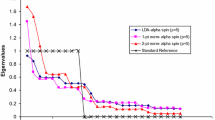Abstract
Three optimization procedures are examined for their utilization in determining the optimum density matrix for a single determinant wave function. The total energy of a molecular system is written as a function of the density matrix and then optimized subject to the constraints of idempotency and total electron population. This direct calculation of the density matrix (DCDM) method was studied in an attempt to have a formalism which would avoid convergence problems associated with the self-consistent field (SCF) cycle, and which would be applicable to large molecular systems. The optimization procedures studied were the Powell algorithm, Gauss-Jordan reduction, and dynamic programming. Computational factors studied include convergence criteria, stepsize, and weight factors for constraint equation penalty functions. The application considered is for HF. An ab-initio SCF method was used to obtain initial values for the density matrix, and its SCF results were compared to corresponding DCDM predictions. Approximations of the quadratic two-electron energy contributions will be necessary to apply dynamic programming, but this appears to be the method most applicable to large molecular systems if an acceptable approximation can be found. Gauss-Jordan reduction is an applicable technique, but probably not for large molecular systems. BOTM appears to be the method most applicable without introducing approximations, but weight factors for the penalty functions will have to be more efficiently determined as Lagrange multipliers, and this addition would result in a technique probably not applicable to large molecular systems.
Similar content being viewed by others
References
Schrödinger, E.,The Relation between the Quantum Mechanics of Heisenberg, Born, and Jordan and that of Schrödinger, Annalen der Physik, Vol. 79, pp. 361–368, 1926.
Slater, J. C.,The Theory of Complex Spectra, Physical Review, Vol. 34, pp. 1293–1322, 1929.
Fock, V.,Naherungamethode zur Losung des Quantenmechanischen Mehrkorperproblems, Zeitschrift fur Physik, Vol. 61, pp. 126–148, 1930.
Slater, J. C.,Note on Hartree's Method, Physical Review, Vol. 35, pp. 210–211, 1930.
Hartree, D. R.,The Wave Mechanics of an Atom with a Non-Coulomb Central Field, Proceedings of the Cambridge Philosophical Society, Vol. 24, pp. 89–132, 1928.
Roothaan, C. C. J.,New Developments in Molecular Orbital Theory, Reviews of Modern Physics, Vol. 23, pp. 69–89, 1951.
Zerner, M. C., andHehenberger, M.,A Dynamical Damping Scheme for Converging Self-Consistent Field Calculations, Chemical Physics Letters, Vol. 62, pp. 550–554, 1979.
McWeeny, R.,The Density Matrix in Self-Consistent Field Theory, I: Iterative Construction of the Density Matrix, Proceedings of the Royal Society of London, Series A, Vol. 235, pp. 496–509, 1956.
Lowdin, P. O.,Quantum Theory of Many-Particle Systems, Parts 1 and 2, Physical Review, Vol. 97, pp. 1474–1489, 1995 and Vol. 97, pp. 1490–1508, 1955.
Dirac, P. A.,Note on Exchange Phenomena in the Thomas Atom, Proceedings of the Cambridge Philosophical Society, Vol. 26, pp. 376–385, 1930.
Hinze, J., andRoothaan, C. C. J.,Self-Consistent Field Calculations, Progress of Theoretical Physics Supplement, No. 40, pp. 37–42, 1967.
Fletcher, R.,Optimization of Self-Consistent Field Linear Combination of Atomic Orbital Wave Functions, Molecular Physics, Vol. 19, pp. 55–63, 1970.
Igawa, A., andFukutome, H.,A New Direct Minimization Algorithm for Hartree-Fock Calculation, Progress of Theoretical Physics, Vol. 54, pp. 1266–1281, 1975.
Cohen, L., andFrishberg, C.,Hartree-Fock Density Matrix Equation, Journal of Chemical Physics, Vol. 65, pp. 4234–4238, 1976.
Nemhauser, G. L.,Introduction to Dynamic Programming, John Wiley and Sons, New York, New York, 1966.
Hildebrand, F. B.,Introduction to Numerical Analysis, McGraw-Hill, New York, New York, 1966.
Powell, M. J. D.,An Efficient Method for Finding the Minimum of a Function of Several Variables without Calculating Derivatives, Computer Journal, Vol. 7, pp. 155–162, 1964.
Luken, W. L., andLeonard, J. M.,KLL Auger Energies for Boron Atomic Ions Based on the Saddle-Point Variational Method, Physical Review, Series 3, Section A, Vol. 28, pp. 532–537, 1983.
Author information
Authors and Affiliations
Additional information
Communicated by F. Zirilli
This paper is based in part on the PhD Thesis of C. A. Waggoner, Department of Chemistry, Mississippi State University. Partial support was furnished by the National Science Foundation, Grant No. Rii-89-02064, the State of Mississippi, and Mississippi State University. Other support was furnished by the Physical and Biological Sciences Institute of MSU and the Office of the Dean, College of Arts and Sciences, MSU. Computer time was furnished by the Thomas E. Tramel Computing Center.
Rights and permissions
About this article
Cite this article
Waggoner, C.A., Combs, L.L. Optimization techniques in energy calculations involving the Hartree-Fock density matrix. J Optim Theory Appl 76, 225–240 (1993). https://doi.org/10.1007/BF00939606
Issue Date:
DOI: https://doi.org/10.1007/BF00939606




